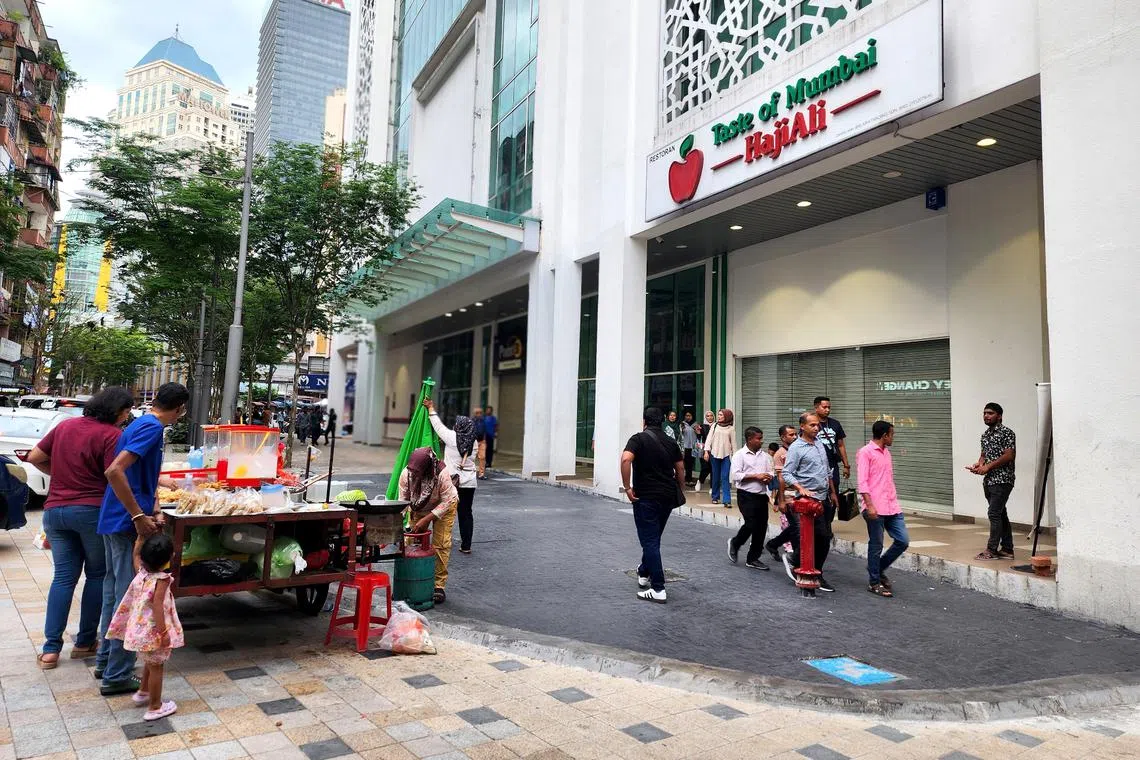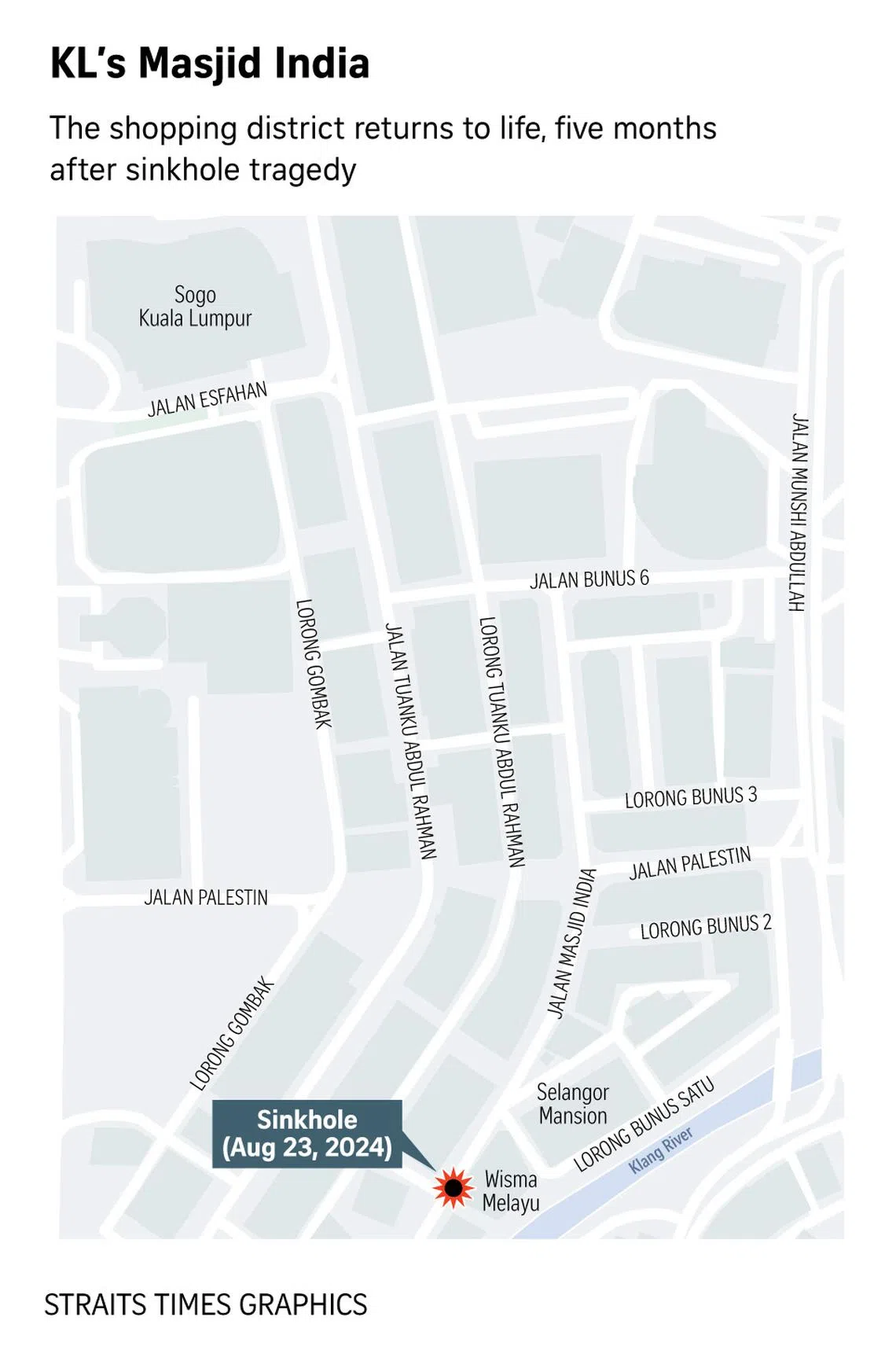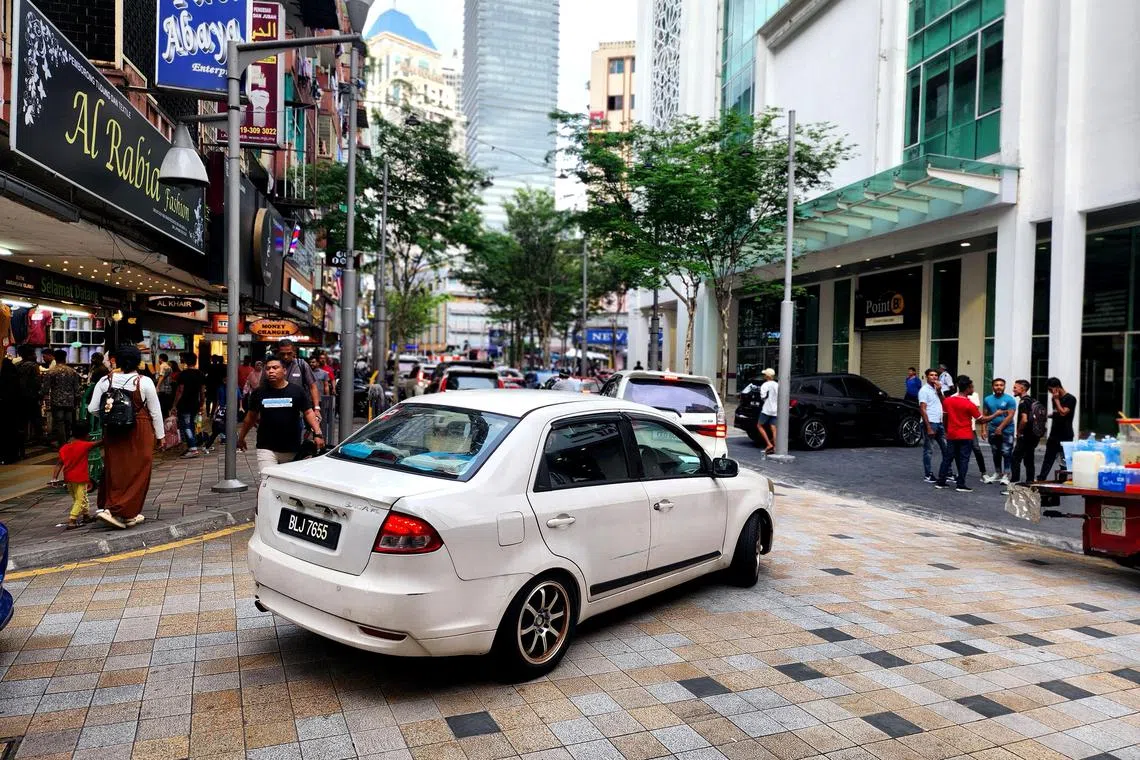KL sinkhole tragedy: Jalan Masjid India shopping area returns to life in time for the festive season
Sign up now: Get insights on the biggest stories in Malaysia

The sinkhole, which has been repaired, has been covered with new black tiles in contrast to the old, light brown tiles around it.
ST PHOTO: HAZLIN HASSAN
Follow topic:
KUALA LUMPUR – A shopping district in Kuala Lumpur is gearing up for its busiest period of the year, five months after it made global headlines following a tragic incident in which a tourist from India fell into a sinkhole, leaving the area bereft of shoppers.
Jalan Masjid India and its surrounding streets form the heart of the old quarters of the capital city’s most popular outdoor shopping district, with its cheap bajus and saris, traditional Indian and Malay food, and an array of gold jewellery.
Many people avoided the area after the Aug 23 incident
Her body was never found, despite frantic search operations
The sinkhole, which has since been repaired, has been covered with new black tiles, in contrast to the old, light-brown tiles around it. Many passers-by have been seen strolling nonchalantly across the tiled-over area.
Located between two of the city’s historic rivers – Sungai Klang and Sungai Gombak – the bazaars and shops of Jalan Masjid India are a must-visit for many Muslims during the Ramadan fasting month, much like the annual bazaars in Singapore’s Geylang district.
Ramadan is just around the corner. In 2025, Muslims are expected to start their month-long dawn-to-dusk fasting on March 1 before celebrating Hari Raya Aidilfitri, which will most likely be on March 31.
Traders busy at work told The Straits Times on Jan 29 that business has improved significantly since the area was reopened to the public about a month ago.
“Business is OK now,” said Mr Anvar Rizan, a manager at a jewellery store opposite where the sinkhole was, adding that things should get better in the coming months, in anticipation of the Aidilfitri celebrations.
Masjid India Business Association president Ameer Ali Mydin said business in the area is “back to 80 per cent”.
He noted that business has improved especially in the past week, as many shoppers flocked to the area because of the Chinese New Year holidays and to stock up on back-to-school essentials ahead of the start of the local academic year on Feb 17.
Although the area is called Jalan Masjid India, there are several other popular shopping streets nearby, including Jalan Tuanku Abdul Rahman, and the stalwart Sogo shopping centre.
Shoppers can access the area easily via two LRT stations, Masjid Jamek and Bandaraya.

Things started looking up for the traders as families and tourists thronged the area during the Chinese New Year public holidays on Jan 29 and 30.
Much-coveted parking spaces were once again filled to capacity, and the bustling streets dotted with sellers of souvenirs and knick-knacks, boutiques and eateries saw a surge of customers. Some vendors were too busy to even pay heed to this reporter on Jan 29.
Ms Shima Ismail, a 25-year-old cashier at the Omar Ali boutique selling traditional Malay garments, described the atmosphere as “very busy” during the Chinese New Year holidays.
She recalled that for weeks following the sinkhole incident in August, business was slow, with no customers at all on some days. This was particularly so when the area where the incident occurred was cordoned off to the public, making it difficult for shoppers to enter the surrounding streets and shopfronts.
“It was quite slow for a while. But now, with Hari Raya (Aidilfitri) approaching, business is picking up... This year, we are seeing more customers too, compared with last year,” Ms Shima said.
The resurgence of shoppers is timely, as Jalan Masjid India prepares for the annual Ramadan bazaar that transforms the district into a vibrant marketplace ahead of Aidilfitri.

The bazaars and shops of Jalan Masjid India are a must-visit for many Muslims during the Ramadan fasting month.
ST PHOTO: HAZLIN HASSAN
Known for its bustling stalls selling everything from textiles and garments to festive decor and food for breaking fast at sunset, the Ramadan bazaar attracts both local residents and tourists.
Despite the revived business activity, some shoppers remain cautious. “I’m a little scared, but it’s OK. I’m shopping for a hijab for Raya and there are plenty of choices here,” said administrative assistant M. Abdullah, 38, admitting that she has not visited the area as frequently since the sinkhole incident.
However, university student Taufiq Morshidi, 34, who visits the area at least once a month to buy nasi kandar and other delicacies, said he is not worried because sinkholes and landslides are not regular occurrences, and they can happen any time.
“I don’t get spooked easily because when it comes to the unexpected, it can happen anywhere, even when you step out of the house, or in your bathroom, even,” he said.
“But I do wish the authorities would pay more attention to infrastructure (issues)... like (having) expanded pedestrian lanes and (better) public transport systems,” he said.
The shopping district, which takes its name from the prominent Masjid India mosque, is known for its vibrant mix of Indian and Malay influences. The area has a rich cultural heritage and is home to many goldsmiths, tailors and shops selling traditional Indian and Malay garments.
As Ramadan approaches, businesses are hopeful that the Jalan Masjid India area will once again reclaim its status as one of Kuala Lumpur’s most popular shopping-street destinations.
The area was fully reopened to the public on Dec 31, 2024,
During the reopening, Kuala Lumpur mayor Maimunah Mohd Sharif said: “The early completion is also to accommodate the shopping and business needs of the public during the upcoming festive seasons.” Datuk Seri Maimunah added that Kuala Lumpur City Hall (DBKL) was reviewing the final report on the sinkhole incident, which will address structural issues and suggest measures to prevent future occurrences.
DBKL has also conducted deep boring tests, repaired walkways and drainage systems, and collaborated with other agencies to fix sewage and utility issues in the area. Periodic monitoring will continue, and RM10 million (S$3 million) has been allocated for further geotechnical research to prevent similar incidents in the future.


